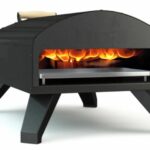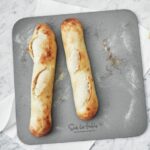The Best Fluffy Pancakes recipe you will fall in love with. Full of tips and tricks to help you make the best pancakes.
Ooni Karu: the second best multi-fuel pizza oven
Ooni Karu Pizza Oven
The Ooni Karu is a multi-fuel pizza oven that’s able to work with charcoal, wood, or gas. It’s the only other model of that kind from Ooni apart from the Pro, of course. The gas burner doesn’t come standard with it – you have to purchase it separately.
It features a robust construction (430-grade stainless steel, reinforced with ceramic fiber insulation), and it also comes with a patented flamekeeper – two features that allow it to retain heat very well for a long time. It has a thick cordierite stone baking board that equally retains heat well and distributes it evenly.
It heats up fast (up to 932°F), cooks fast (takes 45 to 90 seconds), and offers easy temperature/airflow control using the chimney and a rear vent cap. It’s fairly compact and even dismantles and folds down to a portable size that’s easy to store or take on trips. It does lack some accessories, though, such as a built-in temperature gauge and a pizza peel.
Like the Ooni Pro model, the Karu comes in two versions, the Ooni Karu 12 and the Ooni Karu 16. The major difference between the two versions is the size. The Karu 12 is small and can only accommodate pizzas that are up to 12 inches in diameter, while the Karu 16 is large, and like the Pro 16 version, it can accommodate a 16-inch pizza or two 8-inch pizzas at one time. It’s the best option if you plan on entertaining a large group of people.
All the other features are similar, with a couple of exceptions, such as the build quality – the Karu 16 has a powder-coated carbon steel shell instead of stainless steel like the Karu 12. The Karu 16 is also not as compact and portable as the 12 because it’s large and weighs almost double. Both versions come with a 3-year warranty like all the other Ooni ovens.
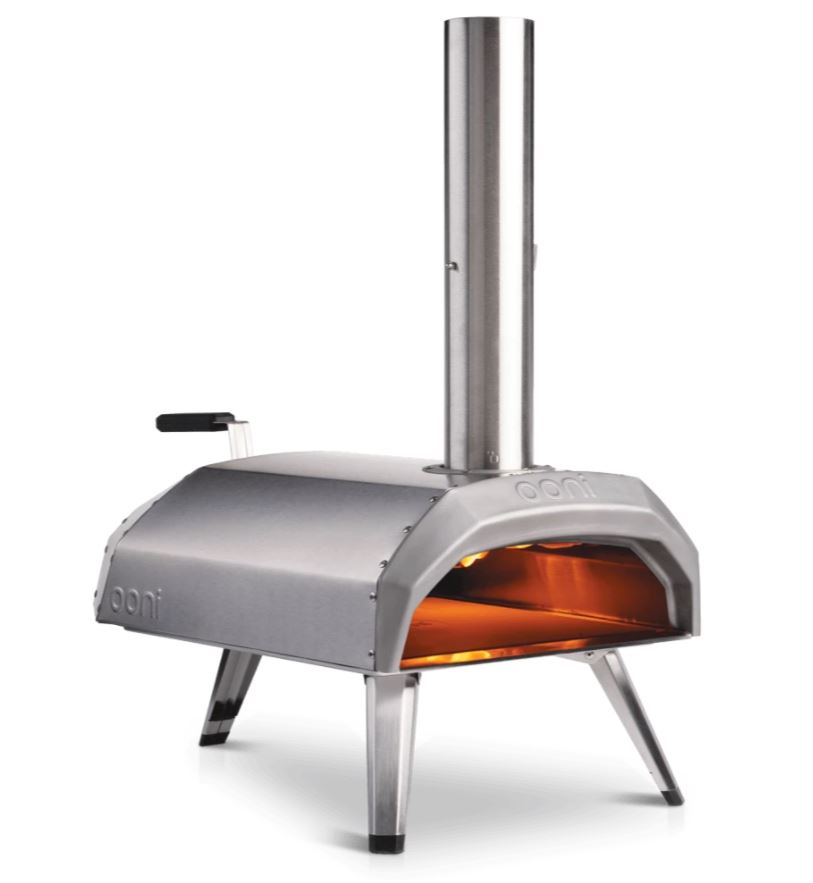
Ooni has really been on top of their game when it comes to producing innovative pizza ovens that are within a relatively low price range yet still deliver great performance. The Karu is the fourth oven from the company that we’ve had the opportunity to put to the test, and much like we had expected, it has been impressive in nearly all aspects.
It was released shortly after the Koda and even came at almost the same price. However, while its predecessor was solely a gas-fueled pizza oven, this one is a multi-fuel oven like the Ooni Pro. It can be fuelled by gas, charcoal, or wood (wood chunks, to be specific). It doesn’t work with wood pellet, though, which sets it apart from the Ooni Pro as far as fuel types are concerned – the Ooni Pro supports all four fuel types.
The other highlight of the Karu is that it has a patented flamekeeper, a feature that allows it retains heat better than the other Ooni ovens and for a long time. It heats up relatively quickly too and requires minor cleanup. We liked it also because its overall build is quite sturdy and durable, and setting it up isn’t that challenging.
The performance and cooking results are where we were pretty impressed with this Ooni Karu model, and this is mainly because it’s able to retain heat very well. It cooked the pizzas fast, and almost all of them came out nearly perfectly. However, it does take some learning curve to achieve the best results, as we learned during our test, especially when using wood.
We’ve had the oven for a while now, and our experience with it so far has been great. Here is our thought on its performance and how it held up when we put it to the test.
Design
The main body of the Ooni Karu has the same classic dome shape design we saw with the other Ooni Pizza ovens and features a chimney just like the Ooni Pro and Ooni Fyra models. The chimney comes off when you convert it to a gas oven setup, so you are only left with the dome-shaped body, which is great if you want a more low-lying oven design like the Ooni Koda.
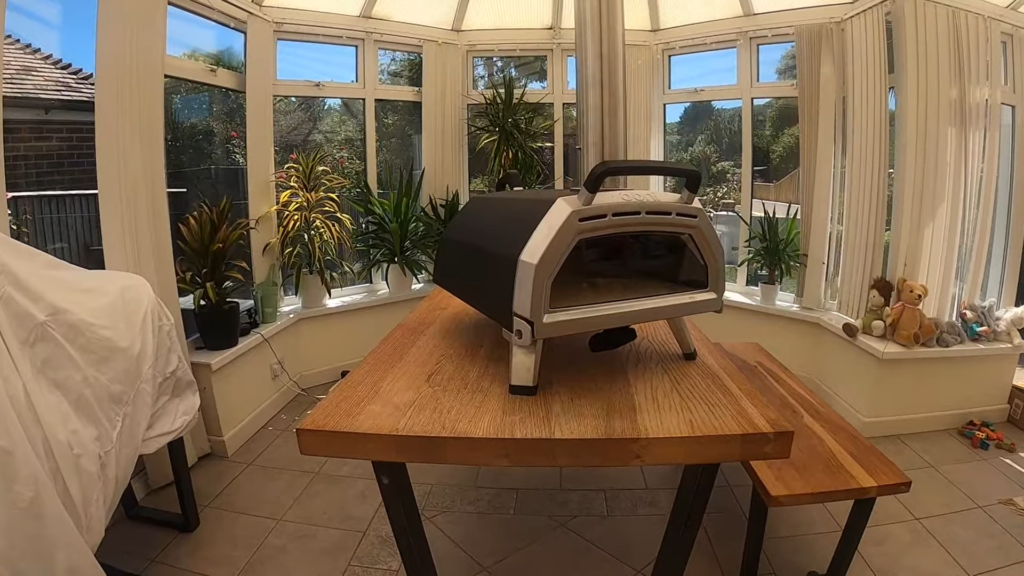
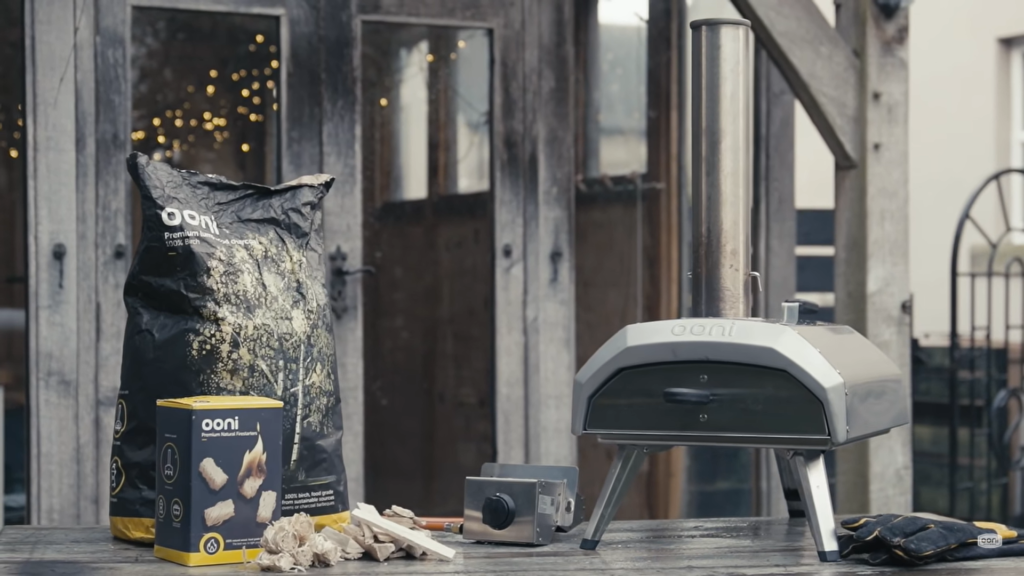
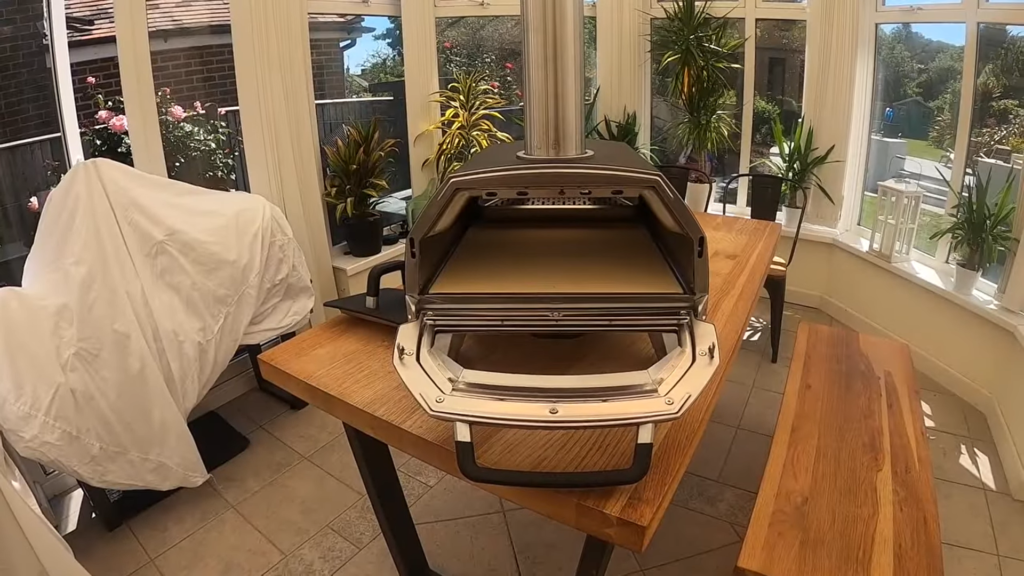
In terms of aesthetics, though, the Karu is rather plain and simple. It has a brushed stainless steel finish throughout, just like the Ooni Pro model – the only thing adding color to it is the black handle of the door and the fuel hatch. It does look sleek and shiny but not that appealing, plus it tends to glare in your eyes when cooking under the sun.
We didn’t really expect it to remain that away forever, and our fear was indeed confirmed – the interior quickly turned black from smoke and heat. The areas around the smokestack and firebox also started to discolor from smoke and heat, and even the pizza stone was starting to develop a patina.
Ooni does offer another version of the same model, named the Ooni Karu 16. It’s larger in size and has the same sleek matte black/silver finish we saw with the Ooni Koda and Ooni Fyra models. It looks more stylish and appealing than the plain stainless steel finish of this Ooni Karu 12 version.
That said, Ooni has included a door with the Karu to help keep the heat inside when cooking, which is a feature that is lacking in the Ooni Koda model. The door itself opens nicely without getting in the way, hence allowing you to slide the pizza easily inside.
The downside is that it doesn’t have a peephole like the one on Ooni Fyra’s door or the pizza door of the Ooni Pro, which features a letterbox-style peephole. The only way to check the pizza is to open the door, which beats the purpose of having it in the first place since you have to constantly keep an eye on the pizza so that you can turn it on time to avoid it getting burned.
When it comes to size, the Ooni Karu 12 measures 28.78-inches long (from the fuel hatch to the door handle), 15.7-inches wide, and 29.32-inches high (from the legs to the chimney cap). It’s slightly bigger than the Koda and Fyra but still compact enough not to take much space on a table.
The favorite part, though, as it is with every Ooni Koda oven, is its portable design. The chimney is completely removable. It features an easy-turning design that allows you to turn it just halfway to detach or lock it in place. You can easily detach it from the oven’s main body when you are done cooking and put it inside the oven itself.
The Karu also features Ooni’s trademark foldable legs. The three legs are not detachable but fold under the oven, flattening it even further to save space and make it more portable. With legs folded, the chimney removed, and everything else dismantled, the oven is reduced to a small, portable form that you can pack away in a bag for traveling outdoors or for storage.
It’s so light (weighs just over 26 pounds) that it can be carried easily by one person – it’s even easier with the smokestack, fuel door, and front door removed to ensure they don’t drop in transit. You can as well remove the baking stone to lessen the load further. The unit is so compact once everything is dismantled that it can easily fit in a small cabinet for storage in case you are not planning to take it away with you.
Our Score: 9 out of 10
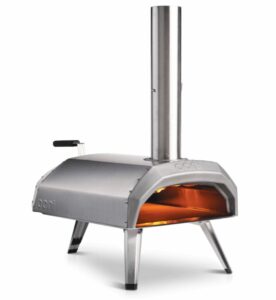
Ooni Karu 12
Build Quality
When we received our Ooni Karu oven and set it up, we could immediately tell it was a robust and well-built unit. The shell/main body is made of thick brushed 430-grade stainless steel, which has been further insulated with ceramic fiber.
The 430 steel used is high-grade stainless steel that’s great in heat resistance, so together with the ceramic fiber insulation, it’s able to keep the heat perfectly inside the oven. Moreover, it consists of 0% nickel, making it ideal for outdoor weather.
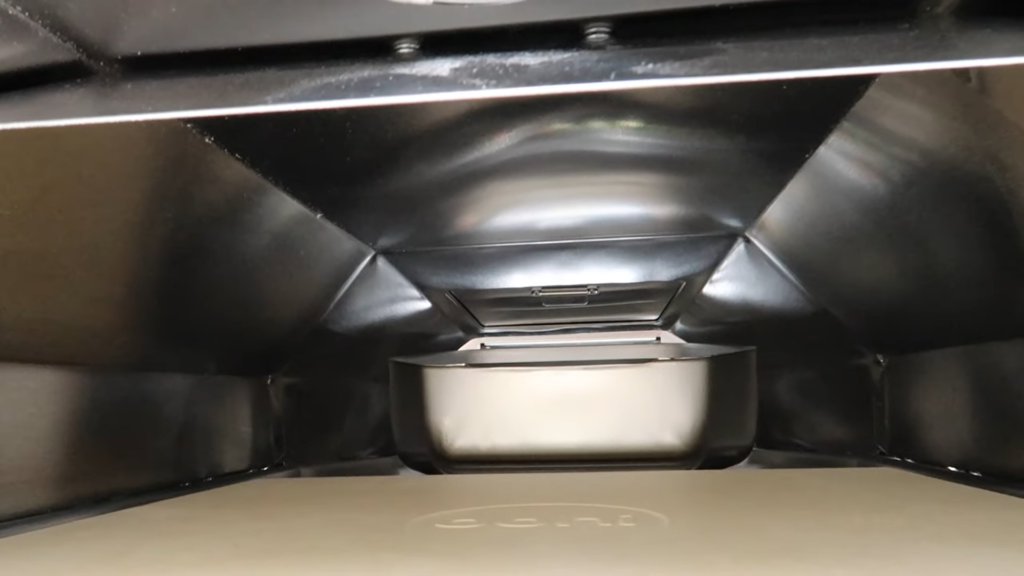
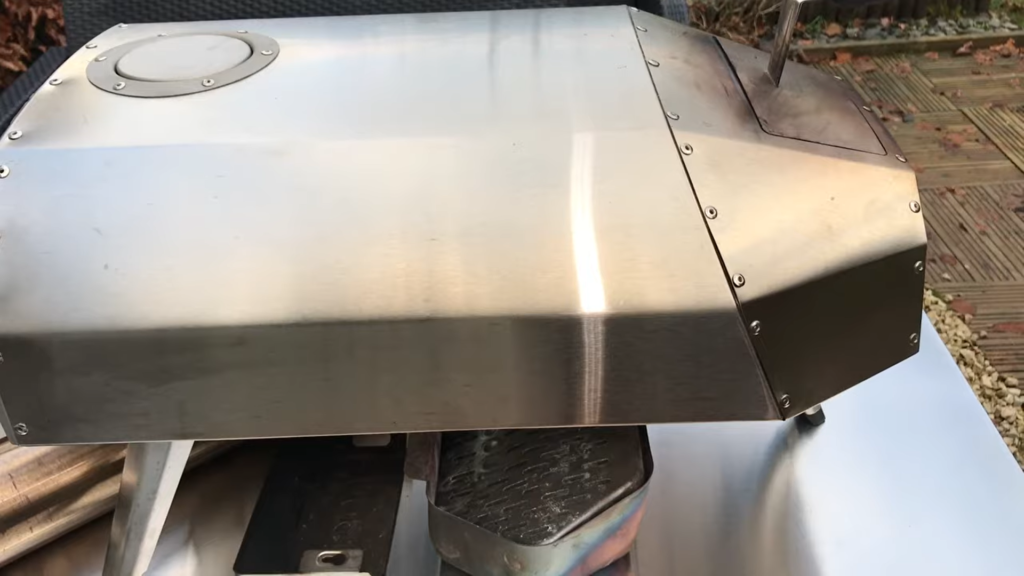
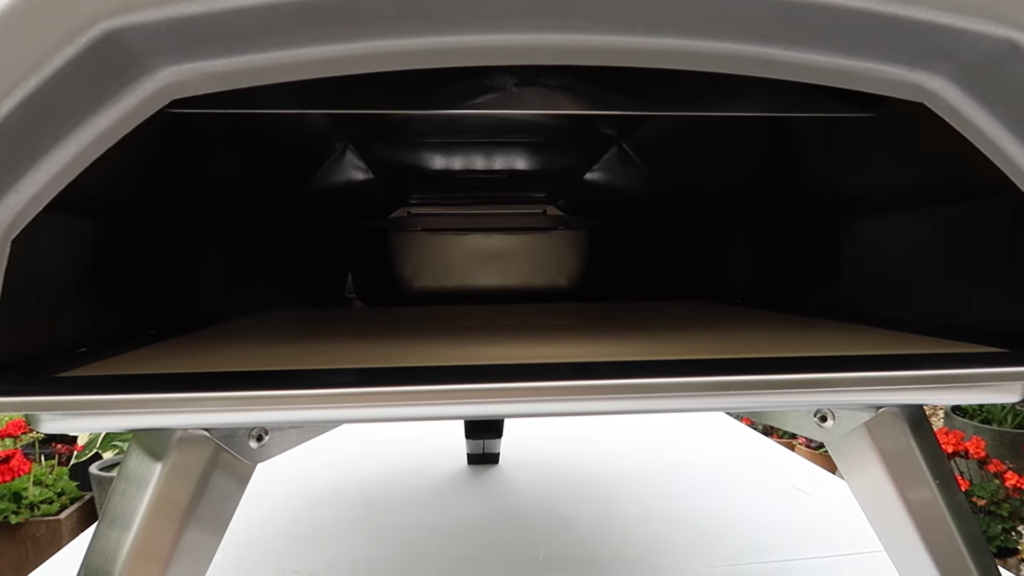
It’s likely to acquire some patina if left most of the time outdoors without any covering, but snow and rain shouldn’t hurt it. Generally, aside from tornados or hail, normal weather shouldn’t cause trouble, although high winds during a rainstorm can push water inside the oven, so getting a cover would be a good idea.
The baking board is a thick, 0.6 inches (15 mm) cordierite stone. It’s thicker than the ones used in the other Ooni ovens. Cordierite itself is a durable stone. The fact that it’s thicker makes it more durable and perfect for retaining heat, which is necessary for cooking crispy, evenly baked pizza bases/crusts.
We also liked that the Karu comes with a door to help keep the temperature hot and steady inside the oven. We noticed that this door is actually a big improvement from the one in the previous models – it’s very solid and insulated; hence, it can trap heat inside effectively.
The whole unit is supported with three sturdy legs, which are equally made of the same 430 stainless steel and fitted with non-slip pads on the bottom to keep the oven stable once it’s set up. It’s not going to move when loading and removing the pizza.
The cool-to-touch handles on the oven door and the fuel hatch are equally of good quality. They are made of glass-reinforced nylon, which does not conduct heat. We noticed that they never get really hot during cooking, making the oven safe and easy to use – you can lift the oven door while cooking without burning your hands.
Our Score: 9 out of 10
Assembly
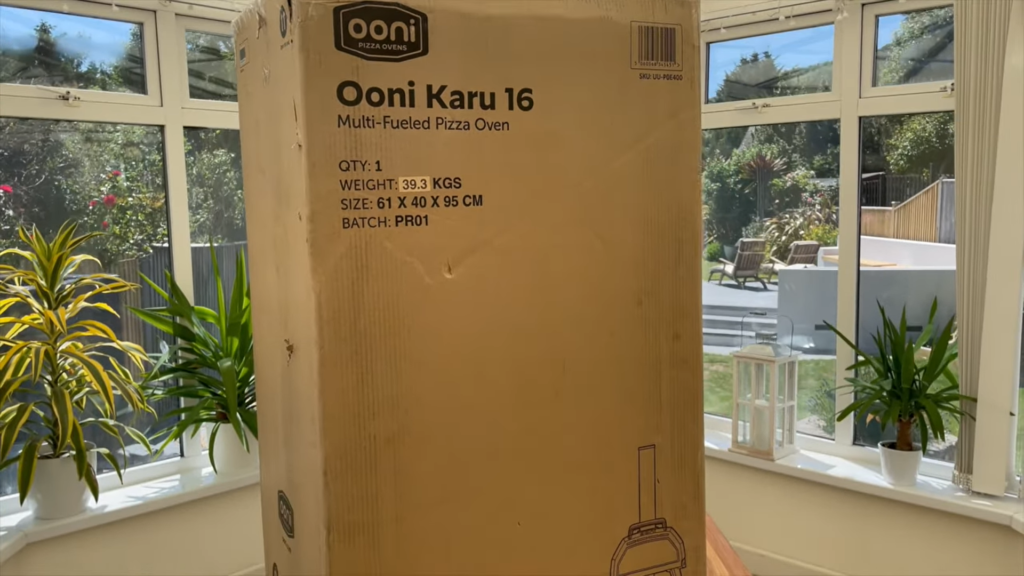
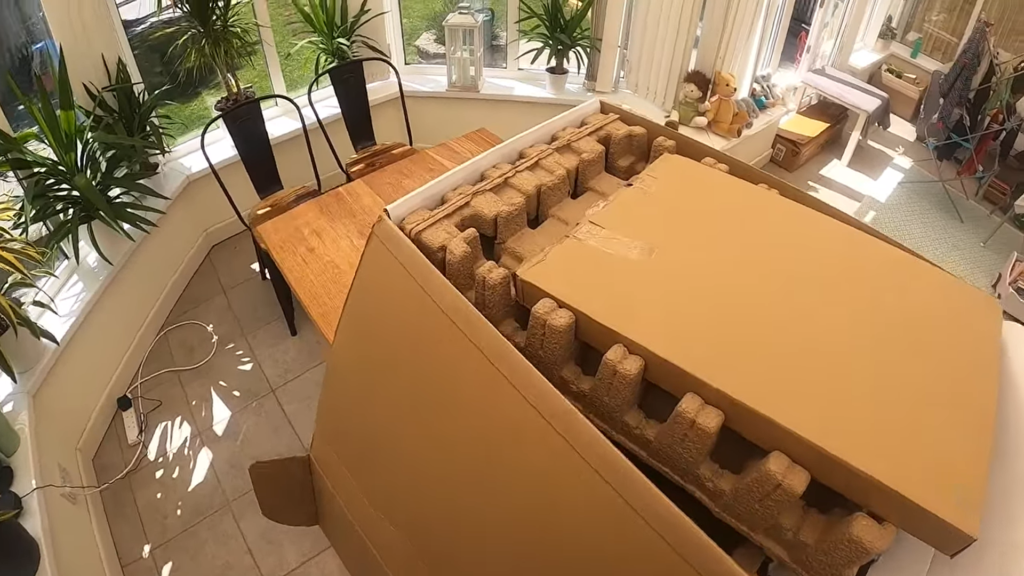
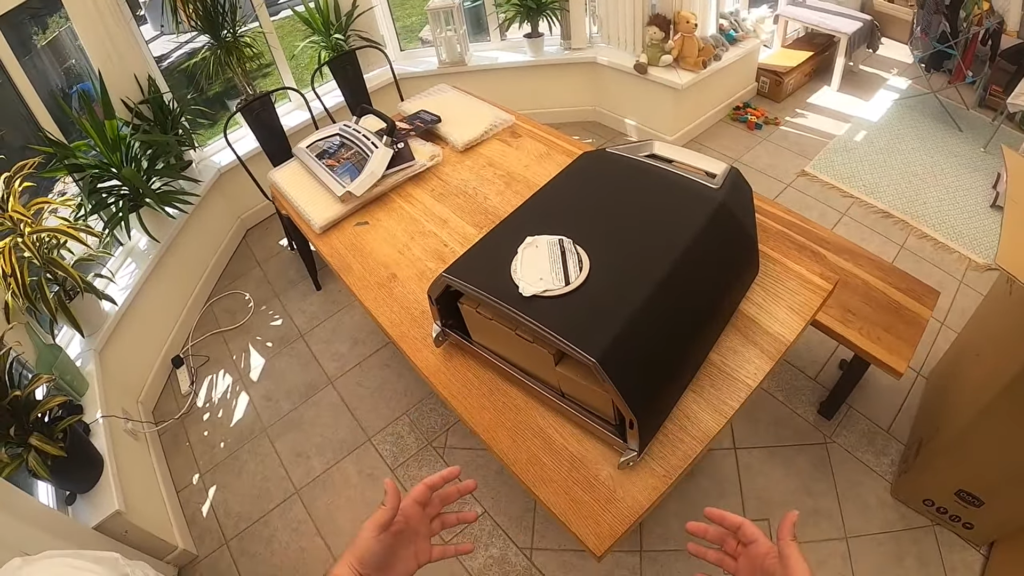
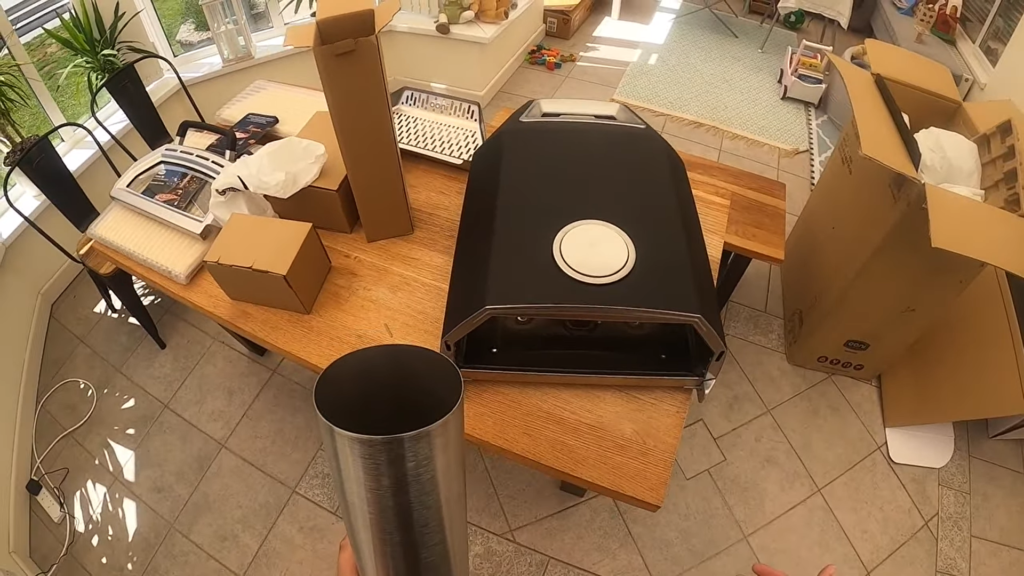
The Ooni Karu comes in a small box with the chimney and other parts stowed inside the oven itself. The package basically contains the oven’s main body, cordierite stone baking board, door, fuel hatch, draft defender plate, fuel grate, fuel tray, and the chimney and its cap. While it’s a multi-fuel oven, the Karu comes with only a charcoal and wood burner as a standard.
We didn’t have any challenge putting everything together because the main body comes fully pre-assembled, so only partial assembly is required if cooking with charcoal/wood, and it’s pretty straightforward.
You just unfold the legs and then insert the burner grate/tray and the pizza stone. From there, you insert the chimney and lock it in place, add the fuel hatch, the draft defender plate, and finally the door, and you’re done. The whole assembly process can take less than 10 minutes, and you won’t need any tools to complete it.
The Ooni gas burner is not included in the package, so you’ll have to purchase it separately if you want to go that route. Converting the Karu to gas is simple, and the only tool you’ll need is the hex key, which you have to use to unscrew two bolts at the back of the oven to remove the charcoal/wood section switch it with the gas burner.
It’s a really simple process. You remove the door and the chimney and then add a chimney cap/stopper in place of the chimney. From there, you remove the fuel grate/tray and the draft plate, add the gas burner and then secure it with an Allen key. It’s a quick and easy process that won’t take more than 10 minutes.
You can set the oven on almost any table; wooden, stone, or steel. The legs keep the hot bottom part high enough that the heat can’t scorch the surface of whatever table it’s placed. You might, however, want to avoid placing it on a plastic table – we would recommend sticking with a sturdy metal outdoor table.
Ooni provides the manual with all the setup instructions for the charcoal/wood burner or the gas burner. The instructions are minimal (which we liked) and very helpful, with clear diagrams to show you exactly what you need to do. An essential guide is also included in the package, which contains tips on using the oven and some great pizza dough recipes.
Before your first cook (whether using the gas or wood/charcoal), you have to “season” the oven in order to get rid of any oils and coatings left inside it from the manufacturing process. This can be done by running the oven at the top temperature for 30 minutes or more. Once that’s done, you can start cooking on it right away.
A few important accessories are missing from the package, though, and you’ll need to get them separately. The first one is an infrared thermometer. The oven doesn’t come with an in-built temperature gauge, so you’ll need to invest in an infrared thermometer/a temperature gun for checking the temperature when preheating and cooking.
The pizza peel is equally not included in the package, so we would recommend getting it if you already don’t have one because it’s quite impossible to make pizzas without one – it’s the only easy way of getting a pizza in and out of the oven.
The other accessory that’s worthwhile is the carry bag which Ooni sells separately. It will help protect the oven at home as well as make transporting and packing it into the car a delight.

Ooni Karu 12
Performance
We experimented with all the three fuel types supported by the Ooni Karu during our tests, and it was able to perform relatively well with regards to reaching high temperatures. It managed to heat up to around 932°F (500 °C) when using charcoal, wood, or gas, which was at par with the other Ooni pizza ovens. However, we noted that the heating time and temperature control differed from one fuel to another.
Pre-heating Time
Our first test was with small blocks of wood, and it came on a chilly day. Of course, we could have waited for much fairer weather, but we were impatient to put the Karu to the test.
The fire was easy to get going. We just added some firewood (there’s a guide in the manual for the optimum type of wood to use) and opened the chimney in order to increase airflow.
Getting the interior up to the specified high temperature (932°F) proved slightly challenging as it took a bit longer since it was a little chilly (around 50°F). Using an infrared thermometer, we found that the oven took around 25 minutes to heat to 600°F (315°C) and another 20 minutes to get to the maximum temperature of 932°F.
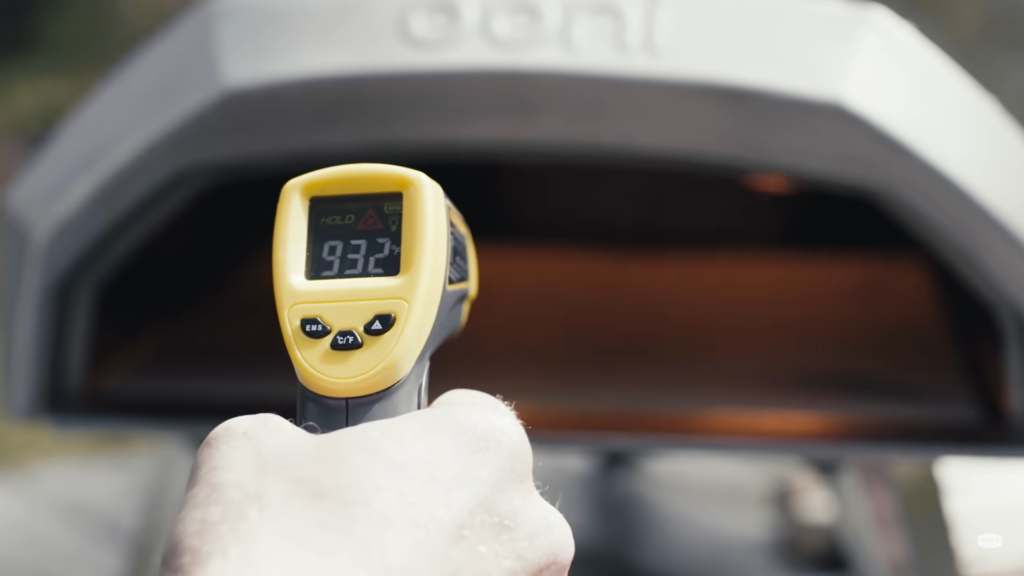
We were generally pleased with that speed (45 minutes in total), though, given that it was wood and on chilly weather, plus we kept opening the door so as to check the temperature with our infrared thermometer since we were not certain how long it would take – in comparison, the Ooni Pro took about the same time to get to 932°F when we tested it, and it was on a warm summer day.
In the same chilly weather with charcoal, we found it took around 25 minutes for the Karu to get up to temperature, which was actually the same rate as the Ooni Pro – on a warm summer day, you can expect it to take about 20 minutes or less.
We also experimented with gas in the same weather, and it did pre-heat fast as we had anticipated. The claim that it gets to maximum temperature in just 15 minutes indeed holds because in our test, it reached 932°F in about 13 minutes, so even on a chilly day, you can expect it to be ready for cooking in around 10 to 15 minutes when using the gas mode.
Airflow System
The Karu offers a decent airflow system that seems to work well to keep the fire burning optimally. It features a perforated fuel grate that sucks in the air from the back, which blows the fire, and then exits through the chimney. Like the Ooni Pro, the Karu also utilizes a custom-designed tray that helps maximize airflow and deliver a strong blast of searing flame.
The perforated fuel grate and the chimney do well to keep the fire/flame on the oven’s roof, thereby distributing the heat from the back to the front of the oven to facilitate a more even cooking.
Ooni has as well designed the Karu such that it’s easier to control the airflow and ultimately the oven’s heat or internal temperature when using solid fuel (charcoal or wood). There’s a key/lever on the chimney, which you can twist to increase airflow in the oven to make the fire burn fiercer or reduce the airflow through the chimney, hence slowing down the fire.
There’s a rear vent cap too that equally allows you to control the airflow and the flames. Opening the vent lets more oxygen in hence making the fire burn more, which in turn increases the temperature, while closing it reduces the airflow, slowing down the fire and leading to a lower heat.
In general, we felt that the Karu offers some control over the airflow and the temperature, although not as good as the Ooni Pro – which had two additional small holes on either side of its opening that further help ensure proper air circulation inside the oven.
It will definitely take some learning curve to control or get the oven temperature consistent, especially with wood chunks as fuel. We had a chilly and windy evening where the temperature was really affected – it took ages to get the oven back up to the right temperature between the pizzas.
When using the gas burner, things are much easier because you don’t have to deal with the vents. It has a heat control dial that allows you to adjust the oven’s temperature to your liking easily.
Heat Retention
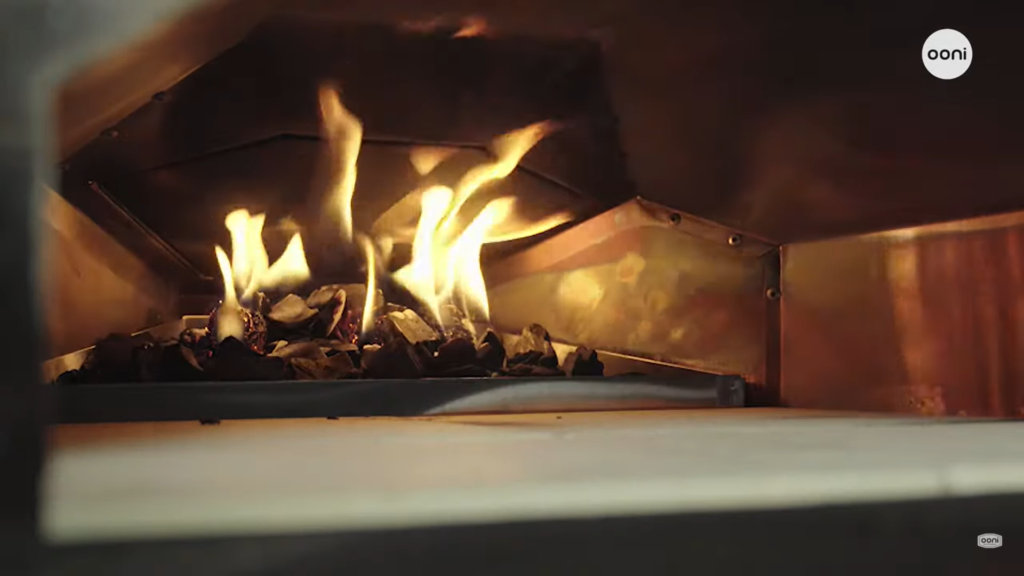
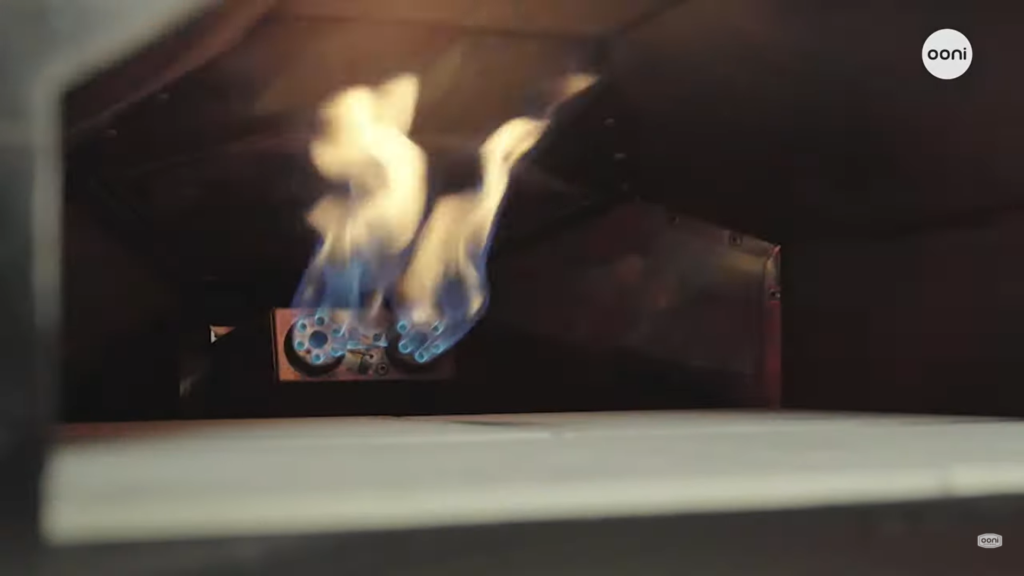
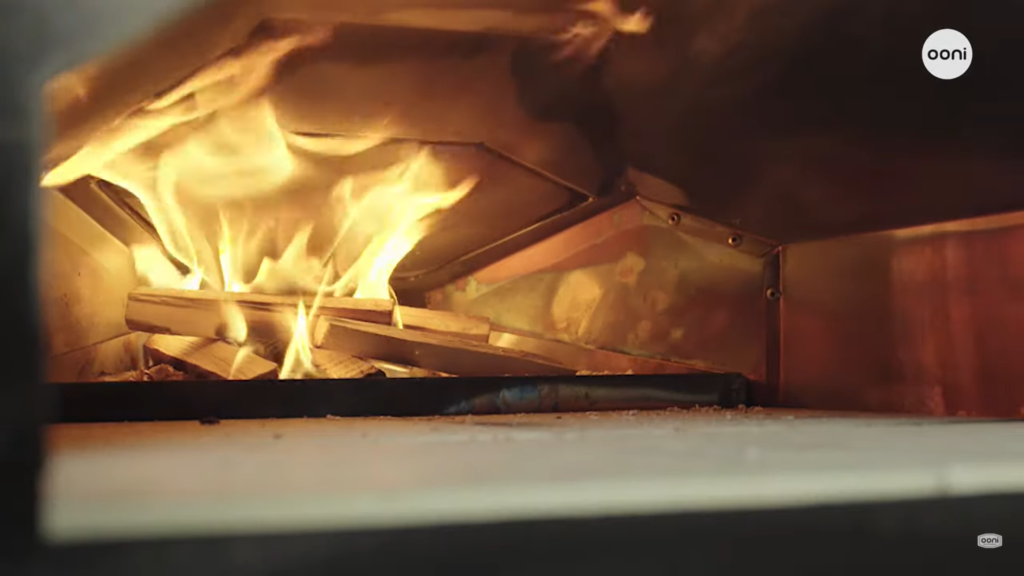
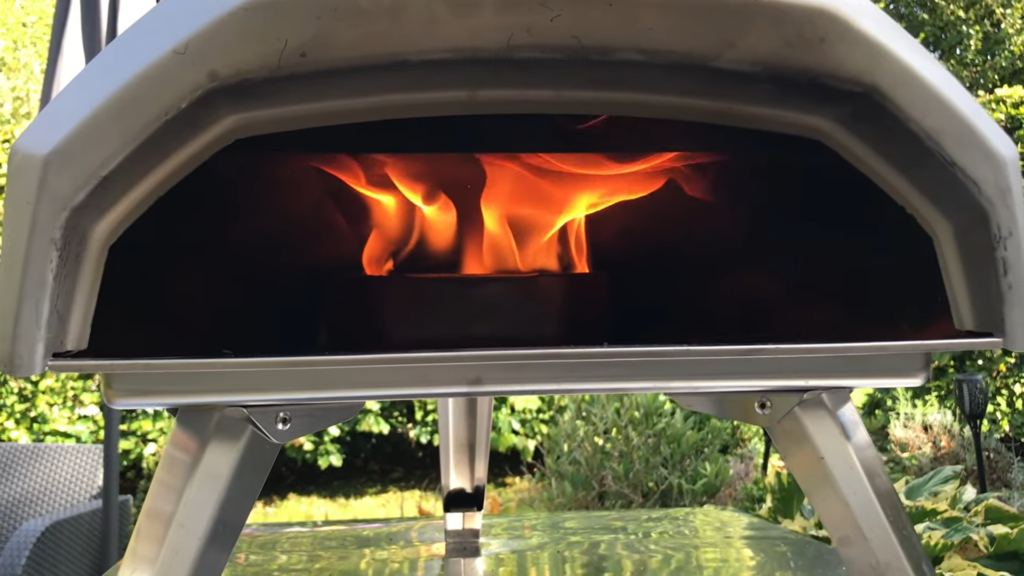
The heat-retention capability of the Ooni Karu was really impressive. It held its heat well, and this is mainly because of its robust insulation and construction. The thick stainless steel body has been surrounded inside with equally thick ceramic fiber, which together creates sufficient insulation that holds all the heat in.
Ooni has also utilized their patented flame keeper design in making this oven, which involves adding a piece of metal beneath the chimney. This design further helps to keep the heat in for a long time such that you are able to still cook even if the oven’s fire is out.
It’s a feature that you won’t find in most pizza ovens and one that we were skeptical about, but only to find out that it actually works. The temperature only dropped by about 10 to 20°F every time the wood ran low, but it would rise again after a minute or two after topping up the wood.
The baking stone is an extra-thick cordierite stone (0.6 inches/15 mm). It retains heat very well and seems to distribute it evenly on its surface, which allows the pizzas’ crust to cook uniformly.
The oven door has also been improved from the previous models like the Ooni Koda and Ooni Fyra as it’s more solid and insulated, plus it fits perfectly to the oven’s opening. It effectively helps prevent heat loss through the opening, so the temperature inside the oven remains hot throughout when you close the door.
Overall, it’s apparent that the design of the Karu makes for excellent insulation, which not only ensures optimum heat retention but also allows the heat to distribute uniformly throughout the interior of the oven, especially when you close the door.

Ooni Karu 12
The Results
The Karu managed to deliver fairly good results with almost every pizza we tried. Cooking with gas yielded the best results, though, as the pizzas turned out almost perfectly with the crusts fully baked and crunchy and the toppings nicely cooked.
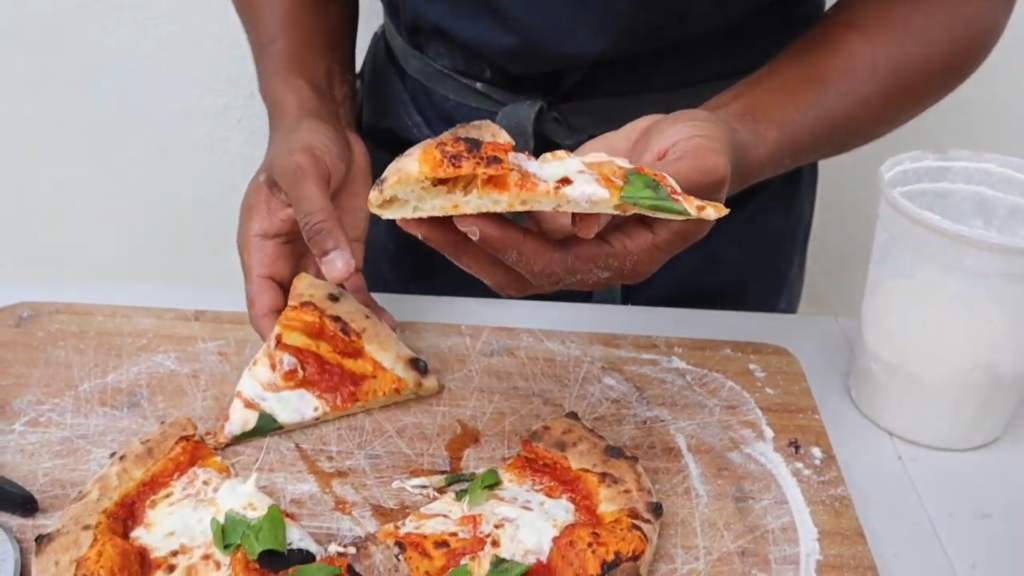
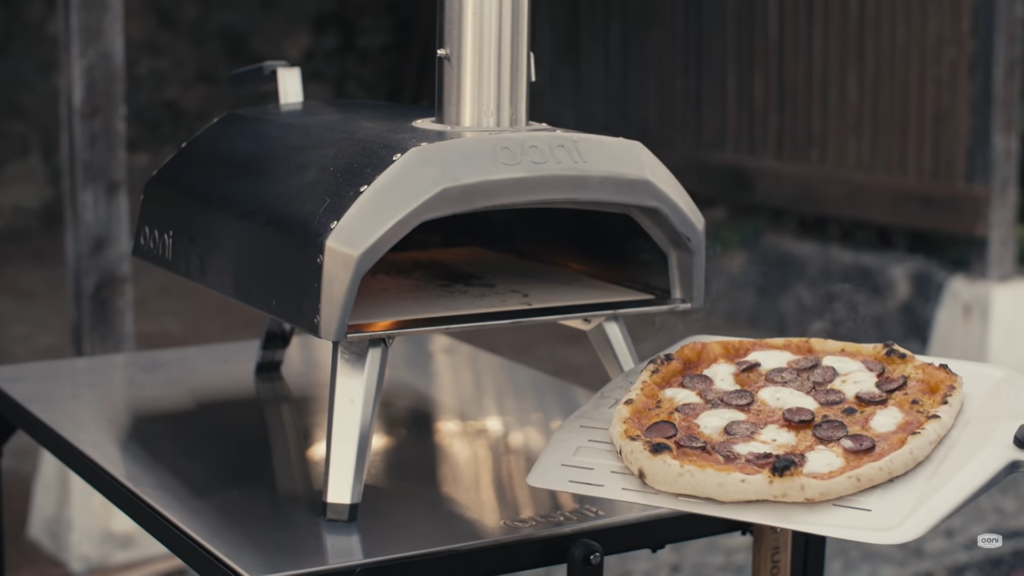
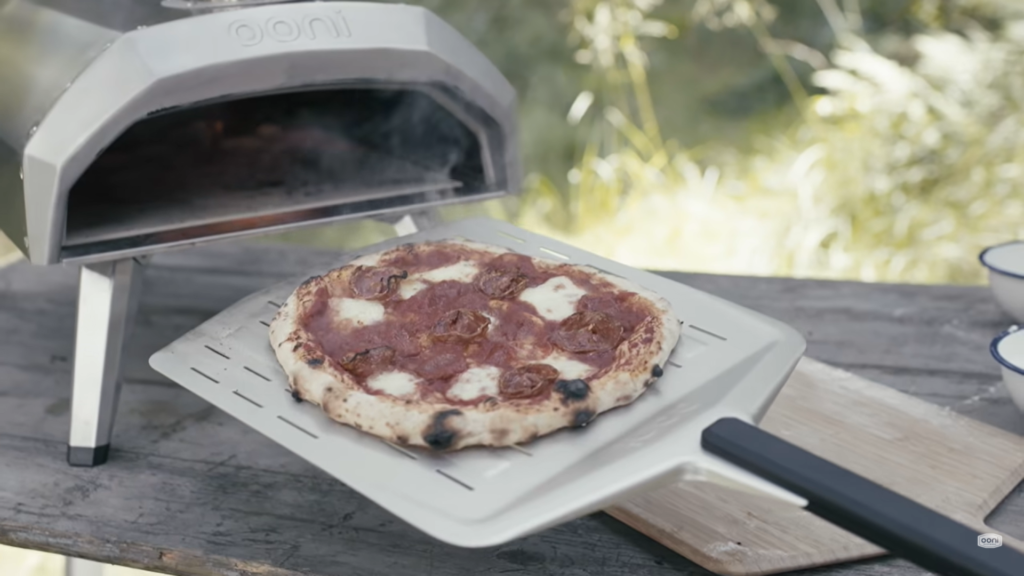
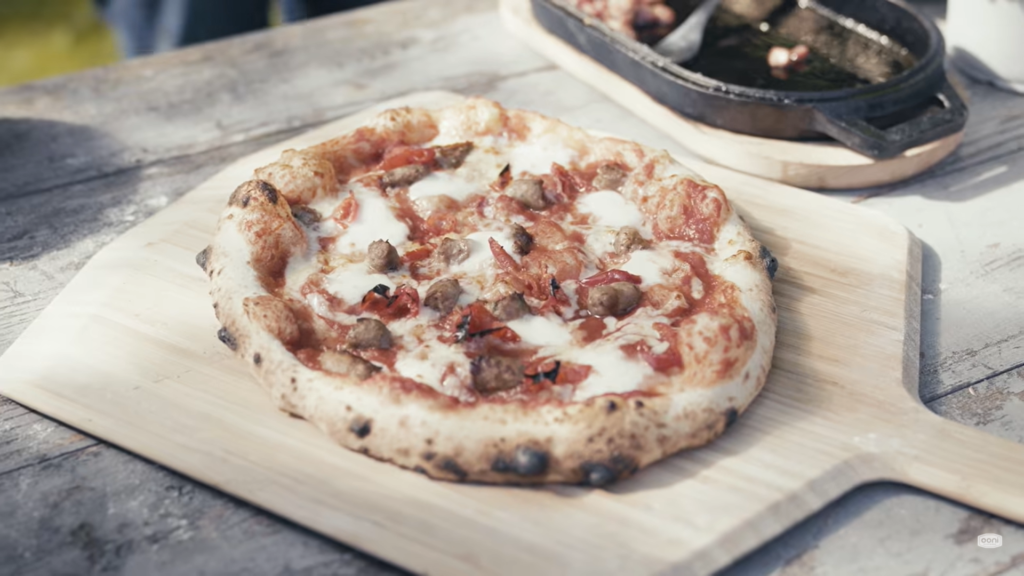
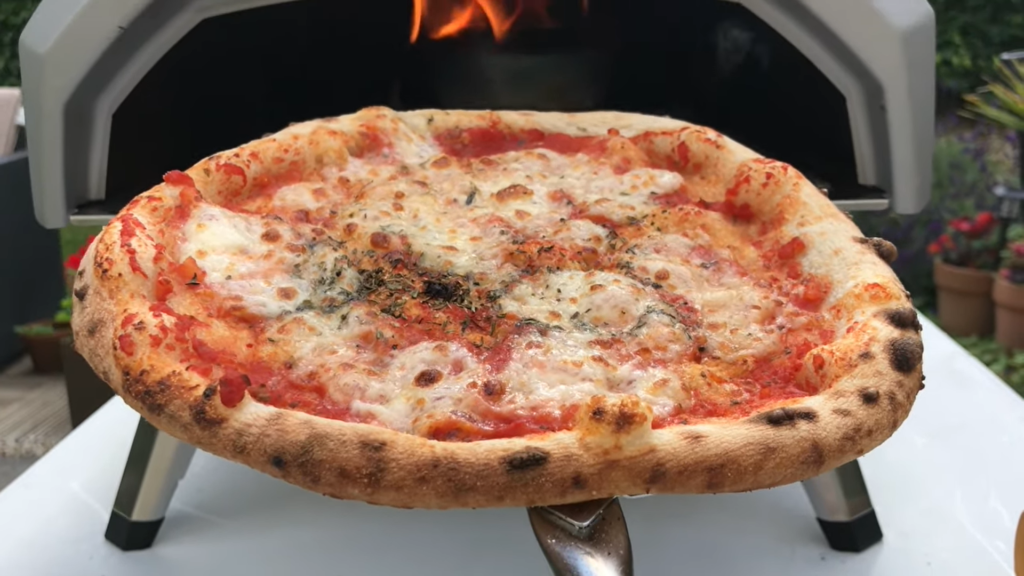
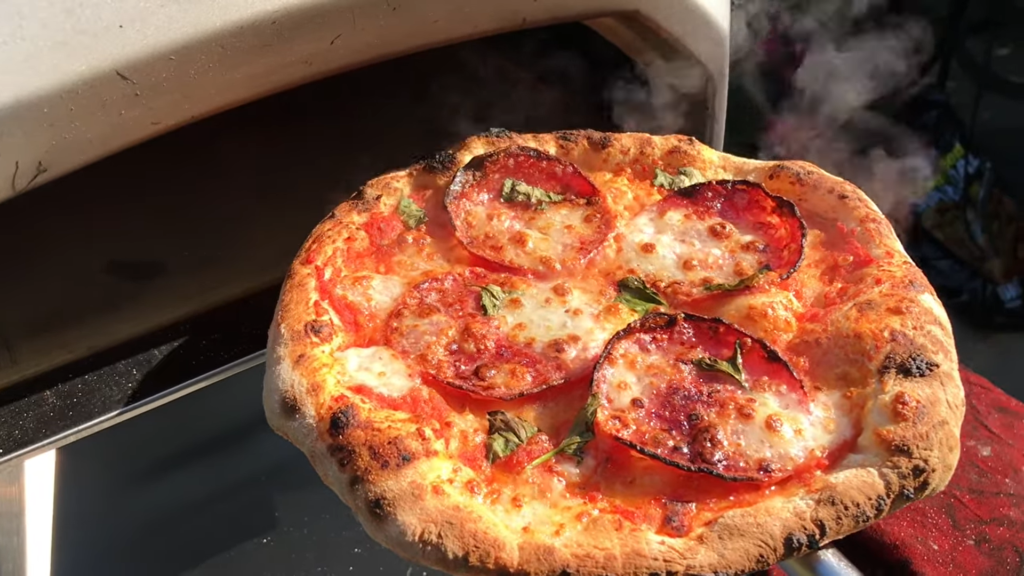
Cooking with Wood
We used wood as fuel in our first cooking session, and we started with just plain cheese pizza. We placed the pizza right next to where the fire is, which is towards the back end of the oven. We rotated the pizza about three times (after about every 15 seconds) to avoid burning the crust’s end that’s directly near the fire.
Our dough wasn’t that thick, so the pizza took less than a minute to cook and was surprisingly successful. It was only slightly burned on one side, but the crust was crispy and cooked through. The toppings were well cooked too. It generally tasted amazing but would certainly not win any awards for presentation.
Our second pizza was also a success, and the ambient temperature was now getting even more consistent, and we took advantage of this to try pizzas with interesting toppings. We went for a pizza with meat toppings made of sausage, onion, mushroom, green paper, and pepperoni – we precooked the sausage so that we could use large pieces without worrying if the interior was fully cooked.
We kept rotating the pizza after every 10 seconds to avoid having any burned sides. The result was impressive – the crust was truly evenly cooked from the base all through to the edges. It had nice blistering and was crunchy and flaky. The pizza tasted really amazing with the wood-fire flavor.
We also tried vegetable toppings (spinach, red onion, artichoke hearts, and garlic) with thin dough. It cooked pretty fast, and the crust was perfectly crisp, but the vegetable topping kept some crunch. We liked the result, although lightly cooked vegetables would be great, too.
By our fourth session, we got adventurous and tried our hand at Calzone, a folded pizza that actually resembles a pasty.
It turned out really well, although we had to reduce the airflow to stunt the flames to ensure that the raised Calzone crust doesn’t end up getting burnt on top – the flames licking across the oven’s roof were so big that if not stunted, the top of the calzone would catch fire. We did just that and definitely got proper bubbling and only a little bit of blackness without burning.
Cooking with Gas and Charcoal
Cooking with gas in the Karu equally yielded great results, even better than wood or charcoal, and it was easier to use than either fuel. The gas burner delivers big, steady flames. The interior geometry of the oven seems to redirect it very well to travel across the whole ceiling – the toppings just inches from the ceiling get cooked perfectly without burning. You also get a nice, crispy crust that’s cooked through.
The front is wide open too when using gas since you have to remove the door, so you get to easily keep an eye on the pizza as it cooks, and the flames don’t get affected much. They are explicitly pointed towards the oven’s center instead of sitting at the back, making them more weather-resistant. Moreover, controlling the flame was easy using the temperature dial knob – you can raise or reduce the heat as you wish.
We didn’t have much success cooking with charcoal, though. We only tried two pizzas, and they turned out badly, after which we abandoned charcoal altogether.
We had used lump charcoal alone since regular charcoal isn’t recommended, and even despite that, we noticed that it couldn’t create flames that licked up across the roof of the oven like the wood fire flames or the gas flames.
The charcoal flames sit at the back, so there’s plenty of heat inside the oven to cook, but without that intense top heat. The result is that the crust gets cooked well at the base, but you end up with a raw center (especially if it’s thick dough), and the toppings don’t get cooked well.
Cooking with the wood wasn’t smooth either. There were a few rogue flames from the back whenever there was a breeze or when you added more wood in the fuel tray or overfilled it. However, it was easier to control the Ooni Karu’s temperature with wood than the Ooni Pro model.
It usually takes some work to maintain temperature with wood fire cooking, but we found the Karu made things really easy. We had no burned pizzas, plus almost all the pizzas came out cooked more even than we anticipated.
The custom-designed fuel tray maximizes airflow, which delivers a hot flame that licks nicely across the oven’s roof, providing the necessary top heat to cook the toppings and the center of pizzas properly without burning. The flame only gets big and unsteady when there’s a breeze or when you top up the wood, but it becomes steady after a few minutes hence keeping the heat inside the oven consistent when cooking.
The thick baking stone provided with the oven also does well to deliver a perfectly cooked crust. It retains heat very well and distributes it evenly on its surface, thereby it doesn’t burn the curst – it absorbs all the moisture in the dough leaving behind a lovely and crispy base almost every time.
However, a few users reported that the stone didn’t get very hot, which caused the bottom of their dough to cook slower than the top. Ours did get very hot (could reach up to 450°C at the center and front), but we had a problem with thick dough.
They didn’t sometimes cook through properly – the center would be raw while the top and the base of the crust would cook well. We decided to keep our dough as thin as possible, and this seemed to solve the problem – the crust came out crispy and cooked through.
Overall, there’s a learning curve involved to get used to the oven and cook pizzas successfully, especially when using wood. One of the tricks is keeping a watchful eye and also turning the pizzas regularly. I did this four times per pizza (every 15 seconds or so) until it was cooked properly.
Besides rotating the pizzas, you have to learn how to control the heat using the rear vent cap and the chimney. The oven tends to burn hot, fast, and clean with it open, while closing it reduces the heat, slowing down the cooking speed and creating more smoke.
We also learned that the pizza’s position on the stone matters a lot – shoving it back to the center of the stone, just right under the top heat, gives you the best results.
Our Score: 8 out of 10
Cooking Time
We found the cooking speed of the Karu to be relatively fast whether using wood or gas. With pizzas set near the back of the oven (closer to the fire), they cooked in around 60 seconds but with the risk of burning the crust.
When we placed the pizzas in the middle of the oven (right under the top heat from the licking flames), they took around 90 seconds to cook, which was just right and seemed actually to be the best spot for the topped pizzas. We tried cooking some of the pizzas closer to the front of the oven, and here, they took about 120 seconds which again was pretty decent but often the crust isn’t as crispy or evenly cooked as when you have the pizzas centered in the oven.
Note that all our pizzas had a thin dough, so depending on where you place the pizza and how thick its crust is, you can expect an average cooking speed of 90 seconds or less per pizza.

Ooni Karu 12
Cooking Space
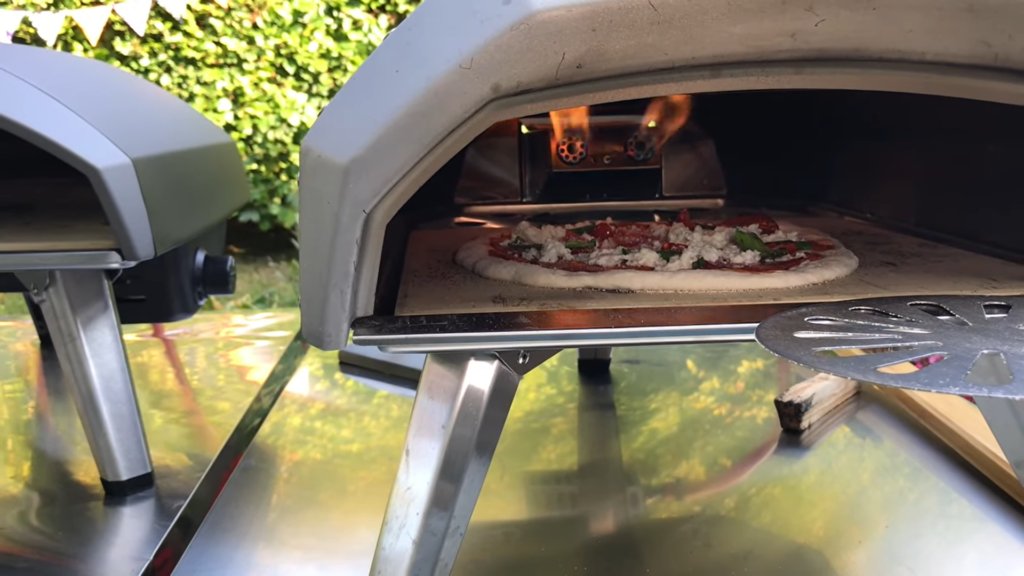
The cooking space of the oven, including the opening, is around 12 inches wide, so it’s large enough to accommodate 12-inch pizzas. It’s ideal for making pizzas for a small family but not lots of people.
The oven opening is about 3.89-inches in height which is a bit low, but the interior height is nearly 5 inches. That’s enough to fit a cast iron pan inside there and cook a variety of low-slung foods such as a steak or fish.
Unfortunately, like the other Ooni ovens, the interior space isn’t sufficient to allow you to turn the pizza while it’s inside the oven. You have to lift it out with the pizza peel, turn it by 90° with your fingers and then return it to the oven. It’s an easy process but not convenient since you have to do it 3 to 4 times per pizza, which isn’t fun and can be tiring when you have a lot of pizzas to cook in a row.
Cleaning
Cleanup is minimal. There’s not much cleaning required between uses. The custom-designed fuel tray delivers high heat, and it’s so efficient that little ash is produced when using wood or charcoal – you hardly have to remove and empty it after each cooking session.
Ooni has included an ash-catcher too, which lessens the cleaning process and also helps keep things tidy. On the other hand, the gas mode provides cleaner cooking because there’s no ash or debris left behind in the fuel tray to clean up after the pizza is complete.
Due to the high cooking temperature, most of the excess flour or food remnants in the oven’s interior and stone get burned off. Once the oven cools down completely, cleaning inside it if needed is simple – you just wipe down the entire interior surface with a dry paper towel to scrub off smoke buildup, and it’s ready for storage or the next cooking session.
Any debris on the stone baking board can be brushed off using the Ooni Pizza oven brush. In case of any food residue that has stuck on the baking stone from dripping sauce or cheese, Ooni recommends scrapping it off and then running the oven at high heat to burn off the rest. That worked really well for us.
If needed, you can also do a more thorough cleaning by removing the stone, scraping off the residue, and rinsing clean the stone using only water – the stone isn’t dishwasher safe, and you shouldn’t use soap.
The oven’s exterior can be wiped clean with just a damp cloth once it’s cool and then dried completely – abrasive cleaning products are not recommended for cleaning the outside surface, but you can use a standard stainless steel cleaner to get rid of any marks or smudges.
Other Highlights
One of the major highlights of the Ooni Karu that we liked is the fact that it’s a multi-fuel pizza oven. It can accommodate charcoal, wood, and gas as fuel sources, which allows for some real flexibility, especially when one type of fuel is unavailable.
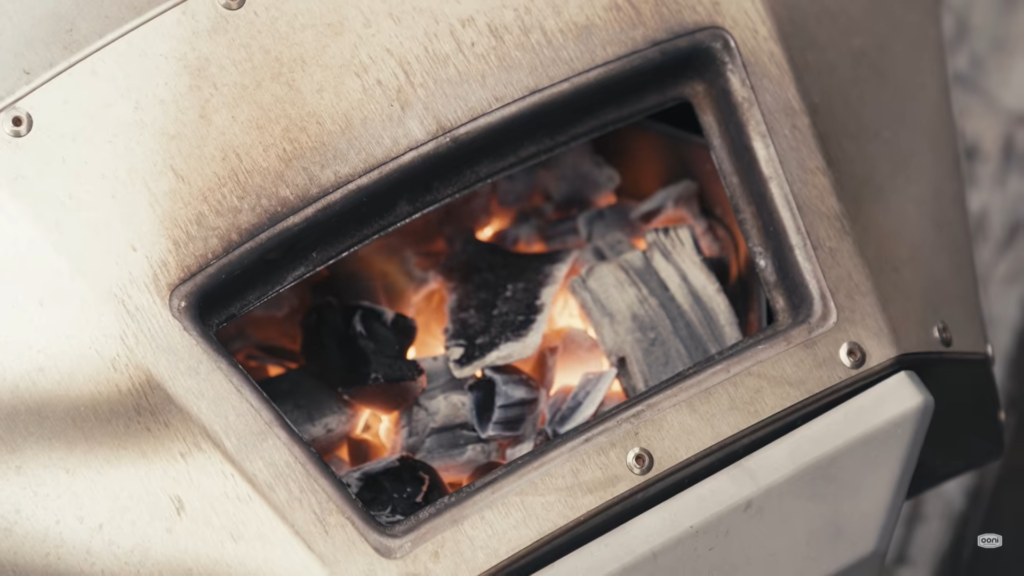
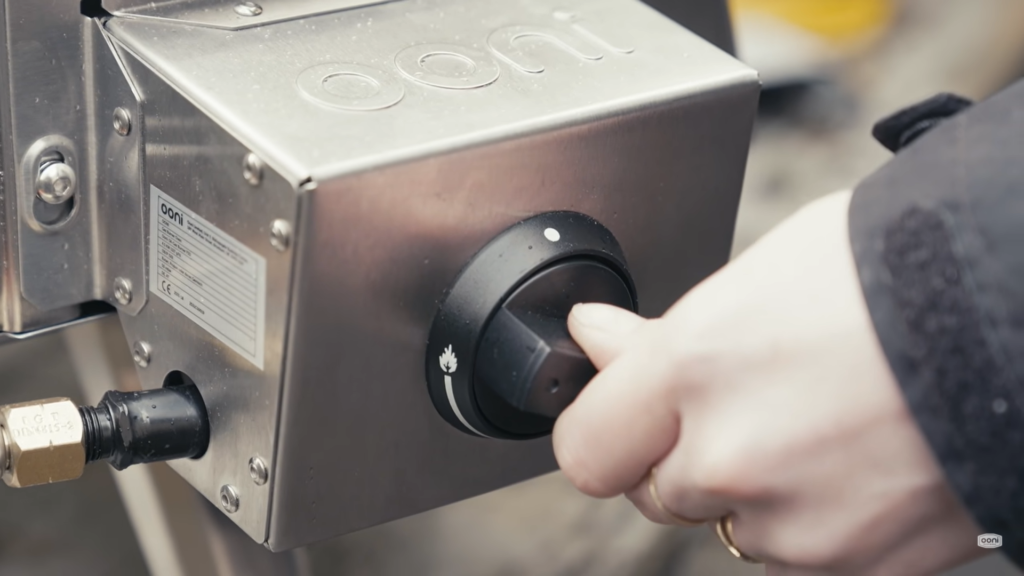
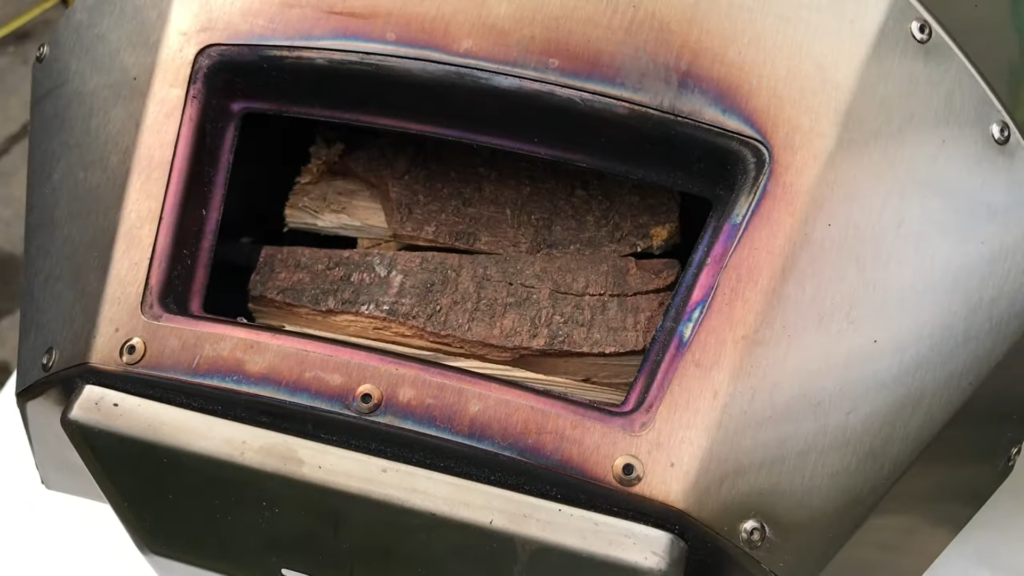
Gas is the easiest, cleanest, and most efficient fuel, but cooking with wood was our favorite because of the wood-fire flavor and because the Karu works efficiently with it compared to the Ooni Pro. You’ll need finger-sized/kindling-sized pieces of wood (approximately 15cm long), and preferably hardwood like oak as it burns hotter.
The wood/charcoal burner itself is very efficient despite being small. It really doesn’t use much wood, so we didn’t have to top up the wood too often when the oven was up to temperature and airflow turned down.
On average, you can cook around ten pizzas with just 3.3 pounds of wood. The only time you get to use a lot of wood is when starting up the fire to get the oven up to temperature – the wood burns fast, requiring topping up after every couple of minutes.
It uses around 0.74 pounds per hour on gas, which is equally efficient and makes gas a fine choice if you have a patio gas cylinder. As we mentioned earlier, we didn’t use charcoal much during our tests, but it’s not quite efficient like the other two fuels as it burns more slowly, doesn’t generate blistering flames, and you have to top it up regularly to keep the oven at high temperatures.
When it comes to handling the Karu, you need to be extra careful since the exterior gets very hot. We had to wear heat-resistant gloves to avoid any burning because even the lever on the chimney as well as the rear vent gets too hot to touch when cooking. Like the other Ooni ovens, the Karu is also for outdoor use only – you can’t use it indoors due to the very high heat.

Ooni Karu 12
Final Remarks
The Ooni Karu is a good-quality outdoor oven and performs very well when it comes to making pizzas. We’ve made good pizzas before on the other Ooni ovens, but the ones from the Karu were stellar. It heats up fairly fast and retains that heat superbly, which allows the pizzas to cook through properly. Almost all the pizzas we made turned out great with a perfect crust.
Besides producing delicious pizzas, the oven is solidly built, versatile, easy to use, and portable enough to take camping or any other outdoor activity. It also comes at nearly the same cost as the Ooni Koda 12 model – you’ll have to incur an extra cost if you choose to use gas because you have to buy the gas burner separately.
Generally, this is an ideal option if you are looking for a small multi-fuel pizza oven. It offers three different fuel options, which means you are not tied down to one particular fuel type. It’s definitely our favorite Ooni oven when it comes to wood fire pizza cooking, although using it takes some practice, especially maintaining a consistent temperature.
It’s a good option too, if you are after a portable pizza oven that you can take with you anywhere. It’s lightweight and disassembles and folds down to a compact size that is easy to carry.

